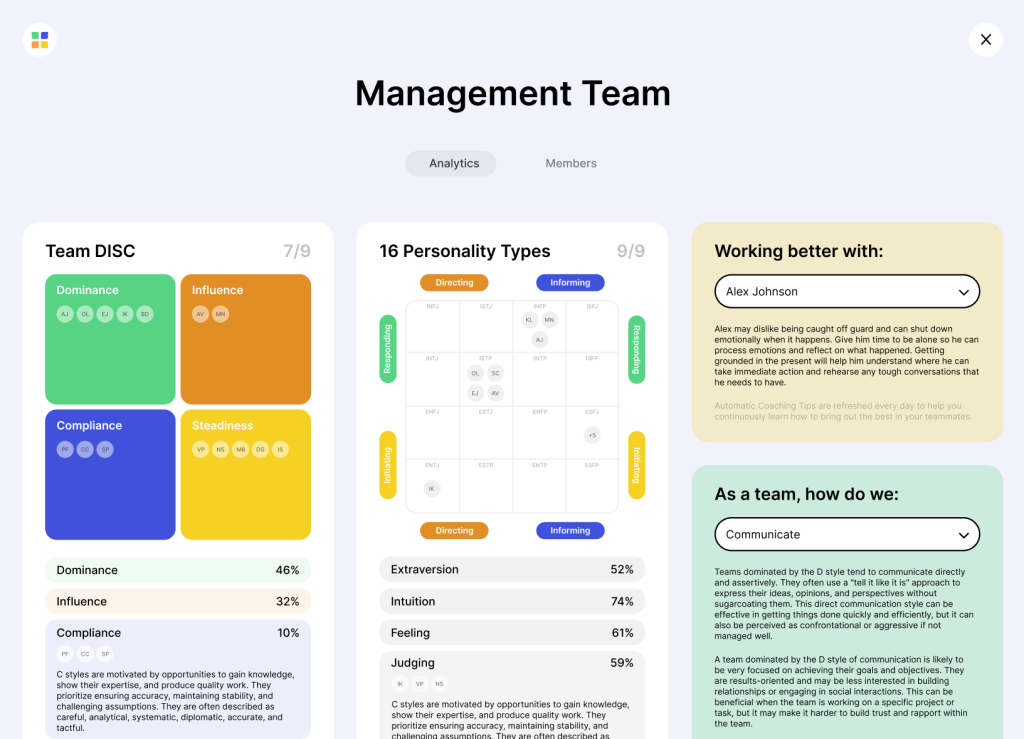Indeed, ESTJ tends to take leadership positions to make sure that everything is done correctly and take charge of the situation. Generally, ESTJs are hardworking individuals with great organizational skills.
They are realistic, practical people with bossy attitudes and high self-esteem. People with this personality type usually bring structure to the situation by setting clear goals and making the future predictable.
However, it turns out that not all the ESTJs have exactly similar decision-making and thinking styles. In fact, ESTJ-A and EST-T are subtypes of ESTJ personality and stand for Assertive and Turbulent Executives, respectively. Although they share the main personality traits, there are some differences between them in the roles they play in various social situations.
In this article, we will compare the strengths and weaknesses of ESTJ-A and ESTJ-T subtypes and point out the major differences between them in social relationships or while working in a team. We will also provide lists of suitable career paths for them and jobs to avoid.
Differences Between ESTJ-A and ESTJ-T
The main difference between Turbulent and Assertive personalities is that the former tend to be emotionally unstable and rather impulsive while the latter is absolutely rational and self-confident.
These tendencies are also present in the case of ESTJ-A and ESTJ-T. In this section, we will discuss the differences between Assertive and Turbulent Executives in friendships, romantic relationships, at the workplace, and while working in a team.
Friendships
The Executives are dedicated friends. They appreciated loyalty from their friends. This may be one of the reasons why they hardly gain new friends.
They usually look at new people suspiciously and can’t connect to them on an emotional level if they don’t share all of their values and opinions. They believe friendships should rely on mutual interests.
Assertive Executives are more open to gaining new friends compared to Turbulent ones. They desire social interaction and want to establish mutual connections with people they trust.
Turbulent Executives also have a need of having people around them. But they perceive friendship a little bit harder than ESTJ-As do. The reason is that they are more sensitive to others’ needs which makes them afraid not to let their friends down.
Relationships
ESTJ in relationships tends to be extremely stable and dependable. Both Assertive and Turbulent Executives have traditional values regarding relationships. They are willing to build long-lasting relationships with traditional gender roles. In relationships, they value mutual trust and respect.
Assertive Commanders are strong and committed lovers. They may seem less concerned about the needs of their partners compared to Turbulent Commanders. But they take relationships very seriously and put enormous effort into making their partners feel happy.
Turbulent Commanders are more sensitive towards their partners’ needs. They are emotionally reactive lovers, always ready to protect their partners and help them solve everyday problems.
Workplace
The Commanders are action-oriented people who are willing to share their innovative ideas with their colleagues. Due to their dedication, ESTJs usually stand out at the workplace. Usually, they are oriented towards achieving their goals.
If a company’s goal is in line with ESTJs’ values, there’s nothing capable of stopping either Assertive or Turbulent Executives from succeeding.
Assertive Executives are rational employees who are willing to debate with their teammates if they are concerned about something. They follow rules, tend to be patient workers, and never let emotions take part in the process of decision-making.
Unlike ESTJ-A personality, Turbulent Executives are less stable. They tend to be nonconformists at the workplace, meaning that they often deviate from the general rules and point out why the current rule doesn’t help in achieving collective goals. Sometimes they even make impulsive decisions.
Working in a Team
Both subtypes of ESTJ enjoy working in a team. As a result of a strong organizational team, they usually motivate the team to put enough effort, focus on the current tasks and achieve the collective goal together. However, they hate working in a team if the team members don’t take care of their own duties.
Assertive Commanders are ambitious individuals who consider themselves very purposeful for the team. They believe that it’s their duty to engage the team even if they are not in the leadership position. They always maintain a strong focus on the team goal.
Turbulent Commanders are rather impatient while working in a team. They easily get annoyed if the members don’t follow the rules and waste too much time while explaining the rules to them. Therefore, they usually prefer working on their own.
ESTJ-As’ Strengths and Weaknesses
Even though all the major ESTJ strengths also apply to both ESTJ-A and ESTJ-T subtypes, there are some aspects in their character strengths that are manifested exclusively in the actions and thoughts of Assertive or Turbulent personalities.
Let’s start with the major personality strengths of the ESTJ-A subtype:
- Self-Confident – Assertive Executives feel completely confident about their actions and thoughts. They don’t care how others think about them and don’t try to fit in. Consequently, their happiness rarely depends on other people.
- Excellent teamwork skills – Assertive Executives are extremely committed to teamwork. They easily manage to distribute the tasks and responsibilities fairly among the team members.
- Loyal and reliable – Assertive Executives value loyalty too much. As a result, they always keep their word. People usually enjoy interacting with ESTJ-As as they perceive Assertive ESTJs as responsible and reliable individuals.
Regardless of these personality strengths, ESTJ-As also have some weaknesses they should work on in order to flourish:
- Too Ambitious – typical Assertive Executives are overly ambitious people. While it can help them achieve goals, sometimes too much ambition pushes ESTJ-As not to put enough effort into the tasks they do, resulting in failures.
- Insensitive – Assertive Executives are perceived as insensitive and unconcerned people. They always put their own needs in the first place forgetting to take care of their loved ones.
- Bossy attitude – Assertive Executives often have a bossy attitude towards other people, even if they are not their managers or leaders. People often find this character flaw a bit annoying in relationships.
ESTJ-Ts’ Strengths and Weaknesses
Similar to the ESTJ-A subtype, people with ESTJ-T also share general ESTJ flaws and strengths. However, due to their turbulent personality, their character strengths and weaknesses differ from Assertive Executives’.
Here are the major personality strengths of Turbulent Executives:
- Take care of others’ needs – despite having the Thinking (T) personality trait, Turbulent executives are very sensitive towards other people’s needs. The fact that emotions play an important role in their lives could be one of the reasons why they easily forgive people.
- Hard-working – Turbulent Executives are not as confident as Assertive ones. Therefore, they work even harder than ESTJ-As to achieve their goals. They never abandon the work even if it’s boring or difficult for them.
- Realistic attitude – Turbulent Executives are very practical and realistic people who tend to focus on the present instead of worrying too much about the future.
On the other hand, Turbulent Commanders also have some personality flaws that need to be taken care of:
- Tendency to “fit in” – Turbulent Executives worry too much about what others think of them. They change their behavior according to others’ expectations and try to “fit in” in order to satisfy otters’ needs.
- Self-doubt – ESTJ-Ts often doubt themselves which makes them uncertain about their actions. As a result, they often defend themselves in front of others even when there’s no need.
- Easily feel offended – Turbulent Executives are emotionally reactive people who easily feel offended by others. They find it hard to control their emotions and often get angry as well.
Jobs and Career Paths for ESTJ-A
There are plenty of jobs that are ideal for both ESTJ-T or ESTJ-A but due to their specific personality strengths and weaknesses, not all ESTJ job paths are suitable for the ESTJ-T subtype.
Turbulent Executives enjoy a well-organized work environment where they have an opportunity to take care of both their own and others’ needs. They can work productively either as leaders or subordinates.
Here is the list of 10 most suitable career paths for ESTJ-T:
- Teacher
- Judge
- Business Manager
- Military Officer
- Financial Counselor
- Real Estate Agent
- Sales Manager
- Building Inspector
- Auditor
- Dentist
Jobs and Career Paths That ESTJ-A Should Avoid
Here are 6 jobs that you shouldn’t do as ESTJ-A:
- Psychologist
- Social Worker
- Art Director
- Writer
- Artist
- Librarian
Jobs and Career Paths for ESTJ-T
As a result of a willingness to create order and organization at the workplace, the supervisory roles are extremely suitable for ESTJ-As. Assertive Executives are committed leaders who have great skills in engaging the team and making them follow rules. Therefore, positions, where they have to obey others’ rules, are not suitable for them.
Here is the list of the 10 best possible career paths for Assertive Executives:
- Politician
- School Administrator
- Project Manager
- Police Officer
- Chief Information Officer
- Hotel Manager
- Civil Engineer
- Chef
- Vocational Teacher
- Fitness Trainer
Jobs and Career Paths That ESTJ-T Should Definitely Avoid
If you are an ESTJ-T, avoid the 6 following careers:
- Child Care Provider
- Actor
- Graphic Designer
- Data Entry
- Preschool Teacher
- Restaurant Host
FAQs About ESTJ-A And ESTJ-T
What does the T mean in ESTJ-T?
T stands for “turbulent” in ESTJ T. Turbulent personality is a subtype of MBTI personality. Since ESTJs are usually nicknamed Executives, ESTJ T stands for Turbulent Executives.
People with this personality subtype tend to have a need for people around them. They value friendship too much, and also, they tend to be committed lovers.
Turbulent ESTJs are deeply concerned about their loved ones’ feelings and try their best to help others feel better. However, they’re very unstable people themselves and can’t manage their impatience while working in a team.
ESTJ personality isn’t rare. To be more precise, people with ESTJ personalities make up about 9% of the general population, which makes them the fifth most common type of MBTI personality after ISFJ, ESFJ, ISTJ, and ISFP.
Since ESTJ A is the subtype of the ESTJ personality, chances are that Assertive ESTJs are also common in the population. However, there are no official statistics about the exact percentage of this subtype in the general population.


